Bombing a Taliban Religious Ministry Building and Killing 30 Civilians in Proximity
by Marc W. Herold
POSTED APRIL 22, 2002 --
In the afternoon (4:30 P.M.) of October 17, U.S. war planes attacked downtown Kandahar city. The ostensible target was the headquarters of the Taliban's Ministry for the Protection of Virtue and Prevention of Vice (Ministry of Amr bil Marouf), located on the central city's Jada Road. Three 500 lb. JDAM bombs were dropped. The first hit an electrical substation located 100 yards away from the Ministry; the second bomb hit and damaged part of the Ministry building; and the third 'precision-guided' bomb struck residences and the like. Kandahar had been without water and electricity since October 15. The only electricity available is from diesel-run generators (but as of October 22, U.S.war planes began attacking trucks bringing-in fuel from Iran). An Indian correspondent writing for the Washington Post from Quetta in early November noted how U.S. bombing of non-military targets was deepening support for the Taliban in Kandahar.1 He also commented on life under U.S. bombs:
"Refugees who said they were from Kandahar described a city with few municipal services in the best of times. The major changes since the bombings began, they said, have been failures in electricity and telephone service. As they have for years, residents use hand pumps to get well water and cook on small wood fires.
The refugees said the city has an ample supply of gasoline, which is trucked in from Iran. In fact, fuel shipments have been moving through the country in such vast quantities that some diesel vendors in Quetta say they make purchases from smugglers at the Afghan border."
Barry Bearak of the New York Times reported that the third bomb had hit a pharmacy killing four civilians and also a tailor shop across the street killing six civilians.2 A report filed later by Eric Slater, mentioned eight civilians being killed by this third bomb.3 A first-hand account provided ample detail:
" Madad Chowk is the busiest intersection in Kandahar. On one side lies the building of the Ministry of Amr bil Maroof (Enjoining of Good). There are shops selling furniture, a Public Call Office and the post office. On the other side is a masjid, car repair shops and shops selling spare parts.
On October 17 it was bombed. Apparently, the Ministry of Arm bill Maroon was targeted. But the timing was murderous: 4:30 PM is one of the busiest times of the day. Planes fired rockets after rockets which hit the Ministry building and the shops next to it. Pedestrians were killed. One rocket fell on a house adjacent to the massaged killing 2 women and children. The rooftops of three homes collapsed. Up to 17 people were killed."4
The independent Afghan Islamic Press (A.I.P.) reported on Wednesday, October 17, speaking via satellite phone with witnesses in the Madad Chowk district of Kandahar, who said bombs had destroyed houses and shops, caused a huge fire.5 No military facilities were close-by. A shopkeeper from Kandahar who had fled to Quetta, said "I've seen the bodies of women and children pulled out of the rubble of their homes."6
Two days later on Friday and Saturday, the U.S. planes returned again to bomb the Ministry building, dropping three more bombs which leveled the building, but also caused carnage in downtown Kandahar, according to refugees who had fled to Chaman in Pakistan. On the 19, the A.I.P. reported seven civilians had been killed and 15 injured in the Friday attack alone. A young man interviewed in Chaman by a CNN correspondent, Amanda Kibel, said he had seen houses bombed that day (the 19th), people trapped under rubble, both dead and injured, and other people desperately trying to pull them out. 7 The U.S. bombs hit the Kepten central shopping bazaar and residences in the Madad area adjacent to the Ministry building, killing 'many' shoppers, I estimated to number at least 15.8 Reuters cited Afghan refugees in Chaman, Pakistan who described the destroyed shopping bazaar, flattened residences.9 Abdul Wadood, 30, said the Madad shopping area was badly damaged by bombs which struck on Friday, the Muslim day of prayer. His two sons were outside the bazaar and they were both hit in the legs, thighs, and arms by flying metal splinters.10 Sultana Bibi, 50, was in the bazaar with her two daughters when the U.S. bomb struck. She experienced injuries to her head, nose and eyes, and remained mute in Mir Wais hospital.11 Mohammed Ghaus, who crossed into Pakistan with his wife and five children, stated that:
“On Thursday night around 10 p.m. and yesterday at 2 p.m. and again last night, there was heavy bombing. The bazaar around the Keptan intersection in the city center was flattened. My neighbor’s house was destroyed. That’s why we left.”
Mohammed Zaman, 45, said he saw people wounded in the legs and arms after Friday's attacks in the afternoon and at night on the center of town. He said several projectiles hit the bazaar. The "bombing was very heavy,'' he said.12
The Times' Stephen Ingram, there 10 days after the U.S. attack, writes similarly:
"..up the street, normality gives way to devastation. A row of little shops has been flattened as though with a giant fist. A metal sign reading 'Hilal Pharmacy' pokes through the rubble. A few men pick through the ruins with bare hands. It is ten days, locals say, since a bomb landed on the row of shops early one afternoon out of a clear blue sky. Two men sitting in front of their shops were killed. No one seems quite able to agree on how many other casualties there were."13
Behind the destroyed shops was the damaged green building of the Ministry of Vice and Virtue.
In Chaman, Richard Lloyd Parry of The Independent, interviewed a 37 year-old man, Abdullah, who arrived in Chaman on the 24th:
"…. with his wife, two children and five nephews….. Last Saturday afternoon, he said, he saw bombs falling on Madad Chowk, one of the busiest crossings in Kandahar. By the time he got there, there were bodies and injured people everywhere. "I saw a man whose body was cut in two at his waist, and a man with no legs," he said."14
No mention other than in the lone article by Barry Bearak in the U.S. mainstream press. Four months later, MSNBC ran a story on the contents 'discovered' in the building of the Ministry for the Protection of Virtue, beginning with a photo that children are flying kites in the clear blue sky again in the district:
A boy flies a kite in front of the destroyed building of the Taliban's
Ministry for the Protection of Virtue and Prevention of Vice in downtown Kandahar [source: www.msnbc.com/news/700051.asp ]
No mention of the 30 Kandaharis killed by U.S. bombs in afternoons with clear blue skies. They are unworthy bodies, undeserving of remembrance here. And kites fly again and satellite dish sales were booming in February receiving 170 channels - four of them showing nothing but porn in a discrete repudiation of the one-time Ministry of Virtue and Vice.15
Footnotes
1. Rajiv Chandrasekaran, "Support Deepens for Taliban, Refugees Report," Washington Post [November 8, 2001].
2. Robert Nickelsberg and Barry Bearak, "On a Taliban-Guided Tour, Facts Prove Elusive," New York Times [November 1, 2001], an A.P report.
3. Eric Slater, "These Spies Called the Shots in Strikes Against the Taliban," Los Angeles Times [February 24, 2002].
4. Suleman Ahmer, "Night of Death in Kandahar: An Eyewitness Account," posted November 4, 2001, at: www.albalagh.net/current_affairs/Kandahar.shtml
5. "Taliban Seize UN Food Warehouses," The Guardian [October 17, 2001].
6. "Civilian Casualties of U.S Bombs in Afghanistan Continue to Rise," Islam OnLine [October 18, 2001], at : www.islamonline.net/English/News/2001-10/19/article1.shtml
7. on CNN Sunday Morning [October 21, 2001 - 10:24 E.T].
8. John Fullerton, "Refugees Say US Planes Blitzed Bazaars," Reuters [Oct. 22, 2001]; but also BBC News Online [October 19, 2001], "US Planes Destroyed Kandahar Bazaars," Frontier Post [October 22, 2001], and France's l'Humanite [October 22, 2001].
9. BBC News [October 19, 2001], Reuters [October 20, 2001], and Reuters, "Refugees Say U.S Planes Destroyed Kandahar Bazaars," dated October 22, 2001. Also John Fullerton, "Refugees Say U.S Planes Destroyed Kandahar Bazaars," Reuters dated October 20, 2001and Mark Baker, "A Once Grand City [Kandahar] Reduced to Ruins," Sydney Morning Herald [October 25, 2001].
10. "U.S Planes Destroyed Kandahar Bazaar," Frontier Post [October 22, 2001].
11. mentioned in Altaf Hussein, "In Kandahar, Life in the Cross-Hairs," Reuters [November 3, 2001].
12. Frontier Post, op. cit.
13. Stephen Ingram, "A Tale of Two Cities in Taleban Capital," Times [November 1, 2001].
14. Richard Lloyd Parry, "For Those Fleeing This is a Border in Name Only," The Independent [October 26, 2001].
15. Andrew Marshall "Staid Afghan City Tunes Into the World of Porn," Reuters [February 14, 2002], at : www.afghanradio.com/news/2002/february/feb14d2002.html . See also Barbie Dutter, "Give Us Liberty, Give Us Hope, Give US Arnie in Terminator," Sydney Morning Herald [December 18, 2001], at : www.smh.com.au/news/0112/18/world/world3.html
Cursor
homepage
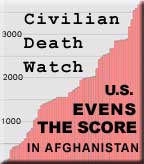
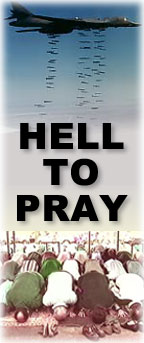

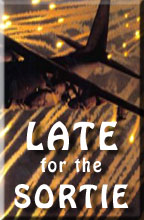
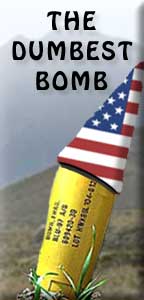
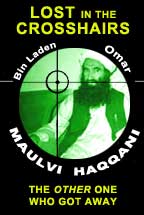
- CURSOR EXCLUSIVE -
January 6, 2002
Recent 'Success' Tally of U.S. Bombs:
Over 200 Civilians are Killed to Get 1.5 Taliban Leaders
- CURSOR EXCLUSIVE -
January 6, 2002
Afghanistan War Produces High Civilians-Killed-Per- Bomb-Dropped Ratio
Appendix 5
Spatial Distribution of Afghan Civilian Casualties Caused by the U.S. Air War, October 7 - December 6th.
Appendix 4
Daily Casualty Count of Afghan Civilians Killed in U.S. Bombing Attacks
A CURSOR EXCLUSIVE
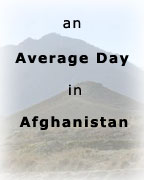
December 29, 2001
The Guardian
December 20, 2001
The Innocent Dead in a Coward's War
Estimates suggest US bombs have killed at least 3,767 civilians
Houston Chronicle
December 20, 2001
We Can't Just Forget
About Dead Afghan Civilians
San Francisco Bay Guardian
December 20, 2001
Life During Wartime
Destroying Afghanistan to save it
WorkingForChange
December 18, 2001
The Forgotten Dead
Do you know how many
have died? Didn¹t think so.
Counterpunch
December 17, 2001
Civilian Casualties:
Theirs and Ours
New York Times
December 15, 2001
An Unlucky Place
An Afghan village where
errant bombs fell and killed,
and still lurk in wait
Monkeyfist.com
December 13, 2001
Bombing & Starvation
Civilian casualties in Afghanistan
TomPaine.com
December 13, 2001
What's Not In The News
Why we aren't hearing the
whole story from Afghanistan
Common Dreams
December 13, 2001
Ari & I
White House press
briefing with Ari Fleischer:
Second question, a
professor at the University
of New Hampshire reported...
FAIR
December 12, 2001
How Many Dead?
U.S. TV networks
aren't counting
Newsday
December 11, 2001
U.S. Wages Overkill in Afghanistan
Common Dreams
December 10, 2001
More Than 3,500 Civilians
Killed by U.S. Bombs
University of New Hampshire
Economics professor releases
study of civilian casualties
in Afghanistan
TomPaine.com
December 7. 2001
Denying the Dead
In Pentagon reports
of Afghan dead, truth
is the first casualty
FAIR
November 8, 2001
Civilian Casualties Not News on FOX News
Slate
November 2, 2001
Moral Equivalence
How many Afghan civilians is the life of one American soldier worth?
Scoop
(New Zealand)
October 26, 2001
Bush's War Threatens Millions With Starvation
Norm Dixon
Coming in January from
Freedom Voices Press
& City Lights Publishers:
"September 11
and the U.S. War:
Beyond the
Curtain of Smoke"
Contributors include:
Wendell Berry
Jeff Cohen
Robert Fisk
Eduardo Galeano
Marc Herold
Michael Klare
RAWA
Ted Rall
Norman Solomon
Cursor
homepage






